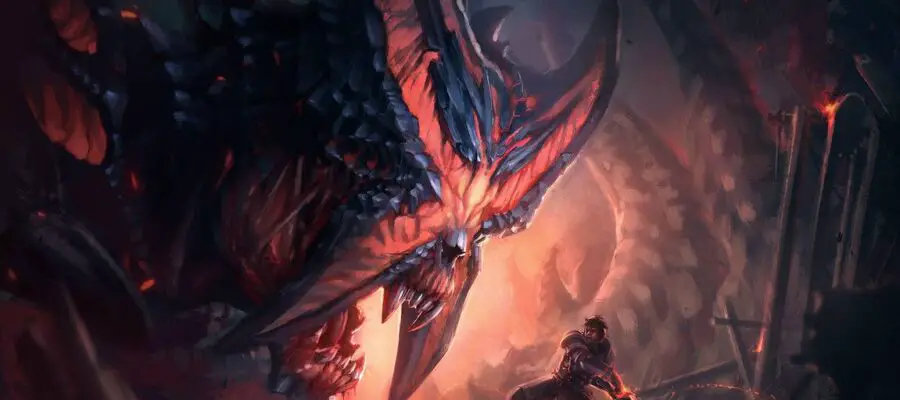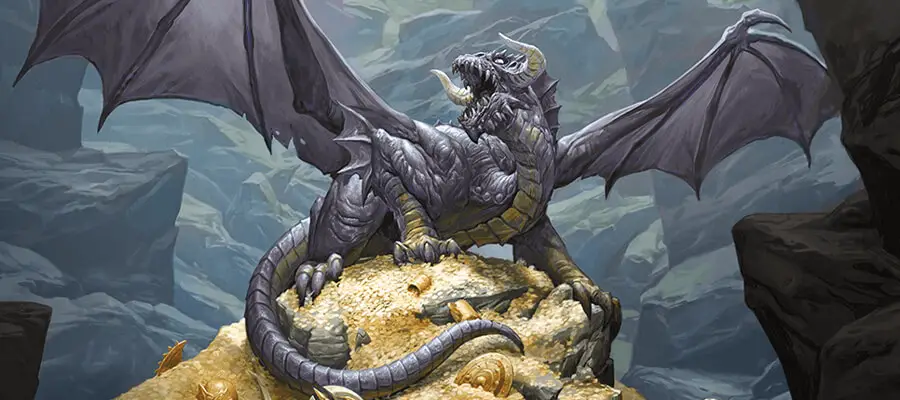Insatiable by drak, used under the Creative Commons Non-Commercial License.
This article contains affiliate links that add gold to our coffers.
I’ve heard many experienced Dungeon Masters agree that they tend to focus on story-writing and role playing in their Dungeons and Dragons campaigns, setting up incredible plot hooks, tying together months of sessions in story, and building out an inspiringly immersive world. All of that preparation often leaves little time for a Dungeon Master to map out a thorough boss fight or enemy encounter. They then resort to overly-simplified or hackneyed battles with predictable maps and bosses.
Ideally, battles should be just as immersive and intriguing as the rest of the campaign. Between interactive map environments and hazards, unexpected legendary actions, and villainous boss lairs, a Dungeon Master can create unique and exciting monster fights for every session, all while progressing the plot through action. To make the process easier, we’ve compiled a myriad of battle-creation assets for Dungeon Masters to access for unprecedented battle encounters.
Use the following formula to create immersive fights:
INTERACTIVE BATTLEFIELD ELEMENTS + BATTLE HAZARD + BOSS/MONSTER with a LEGENDARY ACTION (and LAIR ACTIONS/REGIONAL EFFECTS if appropriate) = A beautifully exciting fight.
Designing Interactive Maps

When a player’s battle abilities are useless in an encounter, such as spellcasters stuck in an anti-magic field or a melee fighter battling against faraway ranged enemies, a player will frustratingly waste their turn doing nothing if there is nothing they can do.
Map provided by mrvalor2017, CC License
For this reason alone, rather than setting up a basic empty battle map, a Dungeon Master should always find ways to include terrain and environment for players and enemies to interact with. Doing something, even if it fails (though I argue a Dungeon Master should be a bit lenient with deploying cool stunts in this scenario), is better than the frustration that comes with doing nothing.
A Dungeon Master can describe the scene before and/or in-battle or provide an accurate map (drawn, printed, whatever floats your boat). We’ve compiled a list of our top battle map elements for player and monster interaction. For more inspiration and maps, see our collection on Pinterest.
Interactive Battle Map Elements
- Hanging Chains. On boats, from rafters, between buildings, off of a balcony, players can attempt to quickly swing around the map. Or, players could entangle enemies in the chains via spells or brute force.
- Spillable things like barrels can put space between a player and an enemy, especially if what’s contained is toxic or undesirable (slag, refuse, angry bees in a barrel, etc). Players could also attempt to trip enemies or stop them from pursuing players.
- Doors that have bars for locking can keep people out—or in.
- Chandeliers are an upscale alternative to chains, but chandeliers can also be cut to crash down upon foes.
- Water covering an area, such as a marsh or a cleaning bucket that has spilled, can create slippery terrain or provide fuel for the Shape Water spell, or provide utility for a water elemental.
- Fire sconces. A player (or enemy) can put out fires to make it dark so that creatures without dark vision can’t see. Or, a sconce can be pulled from the wall by a very strong player to create a makeshift weapon. A player could also use a sconce to light the arena on fire, moving the battle somewhere else (or distracting the enemy enough to get away).
- Ropes around the room or arena have incredible versatility, inspiring players with tactics like creating a trip-line or a makeshift snare.
- Animals, like a horse-drawn carriage, can create a diversion, provide cover or a quick getaway, give players the high-ground, or become heroic mounts in the moment.
- Tables, and things on these tables, have many uses. Prop up the table for cover, break off a leg for a blunt weapon, set up tables to create spatially-unique battles (bottle-necks, mazes, separate enemies, isolate melee foes, etc). Players could jump onto tables to evade the reach of tiny monsters, or jump from table to table to escape enemies.
- Rugs are interesting in-game. A player could pull the rug out from under people or roll up a prone enemy to stop them from moving. Additionally, a player could drag a rug over a trap door or hole for someone to fall into.
- Drapes and curtains can prevent spellcasters from being seen; they can fall onto people like a net; they can create suspense and caution if dividing rooms like a maze.
- On boats, a player can cut down sails onto enemies.
- Players can push boulders off precipices onto their enemies or even push their enemies off cliffs or bridges to their doom.
- Vats of acid can be shifted to splash onto enemies.
- Primitive structures like water- or watch-towers can collapse onto foes, or players can push creatures off of them.
- Terrain like sand can be thrown into enemy eyes; players could hide themselves in terrain and ambush enemies; players can light terrain on fire (dead trees, for example) and control the battlefield.
- Crowds of people or bystanders can shift a fight or affect how players fight.
- Small inconvenient beasts (like cages of skunks or beehives) can be released onto the battlefield, or players can release them themselves.
Include Battle Hazards
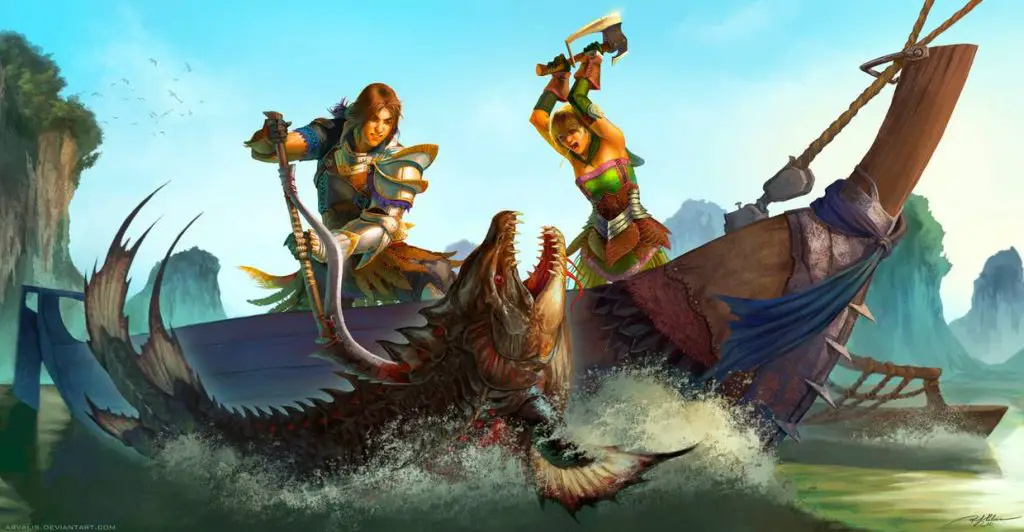
Instill intrigue by making multiple threats apparent in a battle. More than just terrain or map elements players can interact with, battle hazards affect all players on the battlefield, and usually have negative effects universally. Here are our favorite map hazards to include in a battle:
Art by arvalis, CC License
Battle Hazards
- Throughout a battle, rain down natural lightning which lights the terrain on fire, splitting the party, creating visually-hazardous smoke, and creating a risk of falling trees.
- Push the fight to small rocky structures hundreds of feet above a foggy and certain doom (as far as the players can tell). All battle members must jump from one structure to the other.
- Create suspense and force strategy while time is running out before something ominous happens (think guillotine blade slowly sliding down toward the person you need to save, lava filling an enormous basin in a forge before spilling over, or unconscious npc’s being overtaken by quicksand).
- Create a three-way battle, like a band of monkeys trying to steal the gemstone that players are trying to steal from bandits.
- A mudslide or a gas cloud rolls in, forcing everyone to keep moving during the fight. In these moments, you can introduce additional rules similar to chase rules or remove rules like opportunity attack.
- The fight occurs near a cave with growls coming from within. Introduce new monsters or creatures that attack any who get too close.
- Players need to covertly fight to avoid detection, but if they get caught or bloodied, people will know that they were fighting. The punishment could be jail time or being targeted by a mob-like group.
- Hostage situations always provide intrigue in battle.
- Creating a scene where two fights are happening at once for different reasons can create an engaging battle.
- Players must fight around a sleeping behemoth beast that would kill everyone if it woke up.
- Sticky (reduce speed and jump, giving flying creatures or players the upperhand) or slanted floors (roll down ball bearings).
- Sentient trees (like the whomping willows) can shape a battlefield.
- Establish something dangerous above the battle that needs to be help up (like a ceiling of spikes), and someone is stuck holding it on both teams, as both sides can’t rely on each other to keep everyone safe.
- Balance players versus enemies on a plank. Either side could fall off with a shifting of weight.
Give Your Monsters Legendary Actions
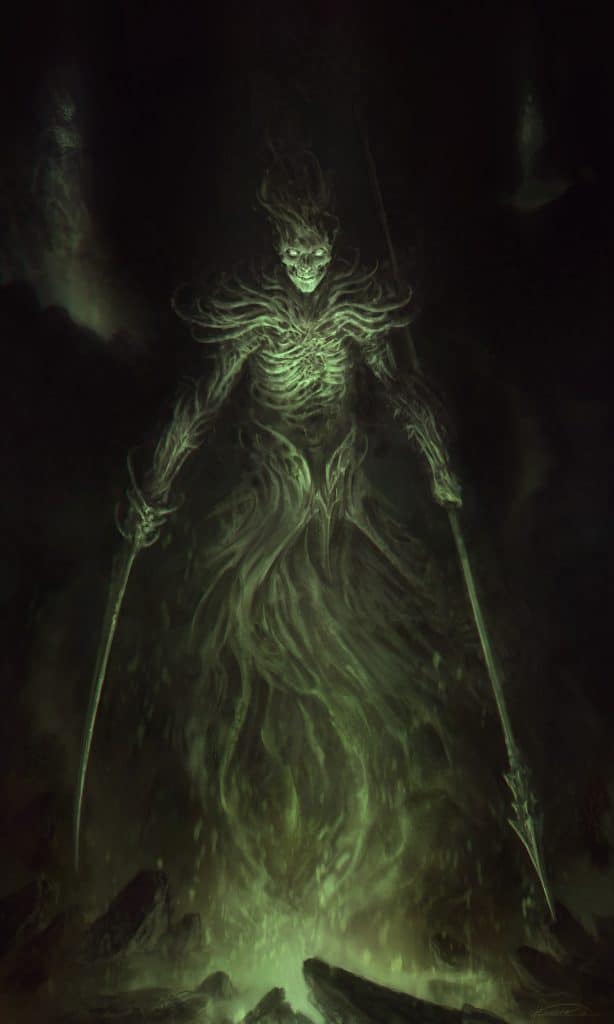
Subvert metagaming and expectations by giving your regular monsters unique abilities. You need not call them “legendary actions” by the book, but along with legendary actions, consider legendary resistances, magnificent weapons, magic items, and minions. See also our section below on Boss Lairs.
Art by 000Fesbra000, CC License
When it comes to developing your legendary abilities, our advice echoes Taking20: you don’t always need balanced encounters on paper. Challenge your players and attack their strengths in battle. I composed a guide to using legendary and lair actions here.
Your legendary actions could be as simple as not provoking an opportunity attack, additional attacks, defense buffs, or taking class abilities like a few Warlock invocations or a Fighter’s Battle Maneuver (see the Battle Master archetype in the Player’s Handbook).
Typically, legendary monsters can take 1-3 legendary actions. “Only one legendary action option can be used at a time and only at the end of another creature’s turn”, regaining their spent legendary action at the beginning of their turn.
Here are some examples of a few legendary actions already existing in core D&D 5e:
Aboleth
- Psychic Drain: One creature charmed by the aboleth takes 10 (3d6) psychic damage, and the aboleth regains hit points equal to the damage the creature takes.
Unicorn
- Shimmering Shield: The unicorn creates a shimmering, magical field around itself or another creature it can see within 60 feet of it. The target gains a +2 bonus to AC until the end of the unicorn’s next turn.
- Heal Self: The unicorn magically regains 11 (2d8 + 2) hit points.
Solar
- Searing Burst: The solar emits magical, divine energy. Each creature of its choice in a 10-foot radius must make a DC 23 Dexterity saving throw, taking 14 (4d6) fire damage plus 14 (4d6) radiant damage on a failed save, or half as much damage on a successful one.
- Blinding Gaze: The solar targets one creature it can see within 30 feet of it. If the target can see it, the target must succeed on a DC 15 Constitution saving throw or be blinded until magic such as the lesser restoration spell removes the blindness.
Adult Black Dragon
- Wing Attack: The dragon beats its wings. Each creature within 10 feet of the dragon must succeed on a DC 19 Dexterity saving throw or take 13 (2d6 + 6) bludgeoning damage and be knocked prone. The dragon can then fly up to half its flying speed.
Lich
- Cantrip: The lich casts a cantrip.
- Frightening Gaze: The lich fixes its gaze on one creature it can see within 10 feet of it. The target must succeed on a DC 18 Wisdom saving throw against this magic or become frightened for 1 minute. The frightened target can repeat the saving throw at the end of each of its turns, ending the effect on itself on a success. If a target’s saving throw is successful or the effect ends for it, the target is immune to the lich’s gaze for the next 24 hours.
- Disrupt Life: Each non-undead creature within 20 feet of the lich must make a DC 18 Constitution saving throw against this magic, taking 21 (6d6) necrotic damage on a failed save, or half as much damage on a successful one.
Androsphinx
- Teleport: The sphinx magically teleports, along with any equipment it is wearing or carrying, up to 120 feet to an unoccupied space it can see.
- Cast a Spell: The sphinx casts a spell from its list of prepared spells, using a spell slot as normal.
Kraken
- Lightning Storm: The kraken magically creates three bolts of lightning, each of which can strike a target the kraken can see within 120 feet of it. A target must make a DC 23 Dexterity saving throw, taking 22 (4d10) lightning damage on a failed save, or half as much damage on a successful one.
- Ink Cloud: While underwater, the kraken expels an ink cloud in a 60-foot radius. The cloud spreads around corners, and that area is heavily obscured to creatures other than the kraken. Each creature other than the kraken that ends its turn there must succeed on a DC 23 Constitution saving throw, taking 16 (3d10) poison damage on a failed save, or half as much damage on a successful one. A strong current disperses the cloud, which otherwise disappears at the end of the kraken’s next turn.
Spice Up Your Boss Lairs
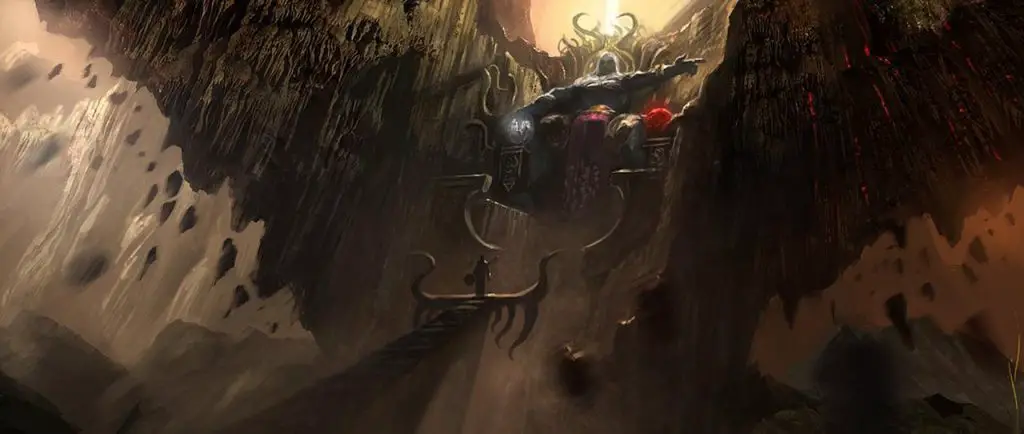
What can a party expect when fighting a boss on its own turf? Whether that be in its homelands, city, or its actual dungeon or lair, a monster or enemy can be made dynamically interesting by adding in lair effects. Like a legendary action, a lair action is an effect that activates once per turn, though when the effects occur is ambiguous. I would recommend at the end of initiative or after the boss’s turn. Keep in mind that most lair actions can’t be used two turns in a row, and by adding lair actions, you are increasing the challenge rating.
Art by eklavvya, CC License
We can brainstorm ideas by looking at what current legendary monsters have in terms of lairs. It is recommended that Dungeon Masters also include regional effects while players are near an undefeated boss’ domain. Once again, I’ll quickly plug our guide to legendary and lair actions here.
Here are some existing lair actions from the basic rules:
- Grasping Tide: Pools of water within 90 feet of the boss monster surge outward in a grasping tide. Any creature on the ground within 20 feet of such a pool must succeed on a DC 14 Strength saving throw or be pulled up to 20 feet into the water and knocked prone.
- Water Rage: Water in the monster’s lair magically becomes a conduit for the creature’s rage. The monster can target any number of creatures it can see in such water within 90 feet of it. A target must succeed on a DC 14 Wisdom saving throw or take 7 (2d6) psychic damage.
- Swarming Insects: A cloud of swarming insects fills a 20-foot-radius sphere centered on a point the monster chooses within 120 feet of it. The cloud spreads around corners and remains until the monster dismisses it as an action, uses this lair action again, or dies. The cloud is lightly obscured. Any creature in the cloud when it appears must make a DC 15 Constitution saving throw, taking 10 (3d6) piercing damage on a failed save, or half as much damage on a successful one. A creature that ends its turn in the cloud takes 10 (3d6) piercing damage.
- Darkness: Magical darkness spreads from a point the creature chooses within 60 feet of it, filling a 15-foot-radius sphere until the creature dismisses it as an action, uses this lair action again, or dies. The darkness spreads around corners. A creature with darkvision can’t see through this darkness, and nonmagical light can’t illuminate it. If any of the effect’s area overlaps with an area of light created by a spell of 2nd level or lower, the spell that created the light is dispelled.
- Volcanic Eruption: Magma erupts from a point on the ground the monster can see within 120 feet of it, creating a 20-foot-high, 5-foot-radius geyser. Each creature in the geyser’s area must make a DC 15 Dexterity saving throw, taking 21 (6d6) fire damage on a failed save, or half as much damage on a successful one.
- Earth Tremor: A tremor shakes the lair in a 60-foot radius around the monster. Each creature other than the monster on the ground in that area must succeed on a DC 15 Dexterity saving throw or be knocked prone.
- Poison Cloud: Volcanic gases form a cloud in a 20-foot-radius sphere centered on a point the monster can see within 120 feet of it. The sphere spreads around corners, and its area is lightly obscured. It lasts until initiative count 20 on the next round. Each creature that starts its turn in the cloud must succeed on a DC 13 Constitution saving throw or be poisoned until the end of its turn. While poisoned in this way, a creature is incapacitated.
- Fog Cloud: The monster creates fog as if it had cast the fog cloud spell. The fog lasts until initiative count 20 on the next round.
- Cold Wind: A blisteringly cold wind blows through the lair near the monster. Each creature within 120 feet of the monster must succeed on a DC 15 Constitution saving throw or take 5 (1d10) cold damage. Gases and vapors are dispersed by the wind, and unprotected flames are extinguished. Protected flames, such as lanterns, have a 50 percent chance of being extinguished.
- Time Warp: The flow of time is altered such that every creature in the lair must reroll initiative. The monster can choose not to reroll.
- Age Warp: The effects of time are altered such that every creature in the lair must succeed on a DC 15 Constitution saving throw or become 1d20 years older or younger (the monster’s choice), but never any younger than 1 year old. A greater restoration spell can restore a creature’s age to normal.
- Plane Shift: The monster shifts itself and up to seven other creatures it can see within in its lair to another plane of existence. Once outside its lair, the monster can’t use lair actions, but it can return to its lair as a bonus action on its turn, taking up to seven creatures with it.
- Lightning Vulnerability: Creatures in the water within 60 feet of the kraken have vulnerability to lightning damage until initiative count 20 on the next round.
- Electric Water: The water in the monster’s lair becomes electrically charged. All creatures within 120 feet of the monster must succeed on a DC 23 Constitution saving throw, taking 10 (3d6) lightning damage on a failed save, or half as much damage on a successful one.
- Spell Regeneration: The boss rolls a d8 and regains a spell slot of that level or lower. If it has no spent spell slots of that level or lower, nothing happens.
- Tethered Lifeforce: The monster targets one creature it can see within 30 feet of it. A crackling cord of negative energy tethers the monster to the target. Whenever the monster takes damage, the target must make a DC 18 Constitution saving throw. On a failed save, the monster takes half the damage (rounded down), and the target takes the remaining damage. This tether lasts until initiative count 20 on the next round or until the monster or the target is no longer in the monster’s lair.
- Necrotic Spirits: The monster calls forth the spirits of creatures that died in its lair. These apparitions materialize and attack one creature that the monster can see within 60 feet of it. The target must succeed on a DC 18 Constitution saving throw, taking 52 (15d6) necrotic damage on a failed save, or half as much damage on a success. The apparitions then disappear.
- Undead Sensing: Each undead creature in the lair can pinpoint the location of each living creature within 120 feet of it until initiative count 20 on the next round.
- Turn Undead Shield: Each undead in the lair has advantage on saving throws against effects that turn undead until initiative count 20 on the next round.
- Spellcasting Pains: Until initiative count 20 on the next round, any non-undead creature that tries to cast a spell of 4th level or lower in the monster’s lair is wracked with pain. The creature can choose another action, but if it tries to cast the spell, it must make a DC 16 Constitution saving throw. On a failed save, it takes 1d6 necrotic damage per level of the spell, and the spell has no effect and is wasted.
Regional Effects
Within the surrounding area of a boss monster’s lair, certain effects should take place that create a spooky ambiance and challenging environment. It could be that magic warps the very air around the lair, or perhaps minions of the boss create such effects, or maybe the boss chose a lair in a very precarious environment such that these effects are natural. Consider the following existing regional effects:
- Extinguished Flames: Open flames of a nonmagical nature are extinguished within the monster’s domain. Torches and campfires refuse to burn, but closed lanterns are unaffected.
- Stealthy Advantage: Creatures native to the monster’s domain have an easier time hiding; they have advantage on all Dexterity (Stealth) checks made to hide.
- Maximum Healing: When an evil-aligned creature casts a spell or uses a magical effect that causes another evil-aligned creature to regain hit points, the target regains the maximum number of hit points possible for the spell or effect.
- Rotting Sustenance: Food instantly molders and water instantly evaporates when brought into the lair. Other nonmagical drinks are spoiled — wine turning to vinegar, for instance.
- Failed Divination: Divination spells cast within the lair by creatures other than the boss monster have a 25 percent chance to provide misleading results, as determined by the DM. If a divination spell already has a chance to fail or become unreliable when cast multiple times, that chance increases by 25 percent.
- Cursed Treasure: A creature that takes treasure from the lair is cursed until the treasure is returned. The cursed target has disadvantage on all saving throws. The curse lasts until removed by a remove curse spell or other magic.
- Slimy Terrain: Underground surfaces within 1 mile of the monster’s lair are slimy and wet and are difficult terrain.
- Tainted Water: Water sources within 1 mile of the lair are supernaturally fouled. Enemies of the monster that drink such water vomit it within minutes.
- Illusory Image: As an action, the boss can create an illusory image of itself within 1 mile of the lair. The copy can appear at any location the aboleth has seen before or in any location a creature charmed by the boss can currently see. Once created, the image lasts for as long as the boss maintains concentration, as if concentrating on a spell. Although the image is intangible, it looks, sounds, and can move like the boss. The boss can sense, speak, and use telepathy from the image’s position as if present at that position. If the image takes any damage, it disappears.
- Overgrown Terrain: The land within 6 miles of the lair takes twice as long as normal to traverse, since the plants grow thick and twisted, and the swamps are thick with reeking mud.
- Foggy Condition: Fog lightly obscures the land within 6 miles of the lair.
- Earthquakes: Small earthquakes are common within 6 miles of the monster’s lair.
- Fire Plane Portal: Rocky fissures within 1 mile of the monster’s lair form portals to the Elemental Plane of Fire, allowing creatures of elemental fire into the world to dwell nearby.
- Control Weather: Once per day, the boss can alter the weather in a 6-mile radius centered on its lair. The boss doesn’t need to be outdoors; otherwise the effect is identical to the control weather spell.
- Stony Clouds: Given days or longer to work, the boss can make clouds and fog within its lair as solid as stone, forming structures and other objects as it wishes.
- Water Elementals: Water elementals coalesce within 6 miles of the lair. These elementals can’t leave the water and have Intelligence and Charisma scores of 1 (−5).
- Aquatic Allies: Aquatic creatures within 6 miles of the lair that have an Intelligence score of 2 or lower are charmed by the monster and aggressive toward intruders in the area.
Conclusion
When creating an encounter, consider adding in surprising elements for players to interact with. Describe the battlefield during the fight, and challenge their strengths with battle hazards and battlefield effects. Spice up your boss by adding in a few legendary actions. Throw balance to the wind by including lair actions and regional effects. With this formula in mind, throwing together a robust and arousing fight will be a cinch.

